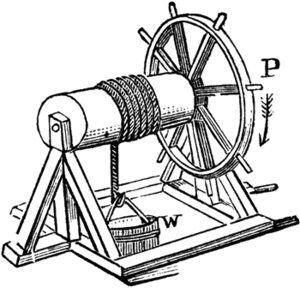Simple Machines
Wheel And Axle

A second variation of the lever is the simple machine known as a wheel and axle. A wheel and axle consists of two circular pieces of different sizes attached to each other. The larger circular piece is the wheel in the system, and the smaller circular piece is the axle. One of the circular pieces can be considered as the effort arm of the lever and the second, the resistance arm. The place at which the two are joined is the fulcrum of the system.
Some examples of the wheel and axle include a door knob, a screwdriver, an egg beater, a water wheel, the steering wheel of an automobile, and the crank used to raise a bucket of water from a well. When the wheel in a wheel and axle machine is turned, so is the axle, and vice versa. For example, when you turn the handle of a screwdriver, the edge that fits into the screw head turns at the same time.
The mechanical advantage of a wheel and axle machine can be found by dividing the radius of the wheel by the radius of the axle. For example, suppose that the crank on a water well turns through a radius of 2 ft (61 cm) and the radius of the axle around which the rope is wrapped is 4 in (10 cm). Then the mechanical advantage of this wheel and axle system is 2 ft divided by 4 in, or 6.
Additional topics
Science EncyclopediaScience & Philosophy: Linear expansivity to Macrocosm and microcosmSimple Machines - Levers, Mechanical Advantage, Pulleys, Wheel And Axle, Inclined Planes, Screws, Compound Machines - Wedges